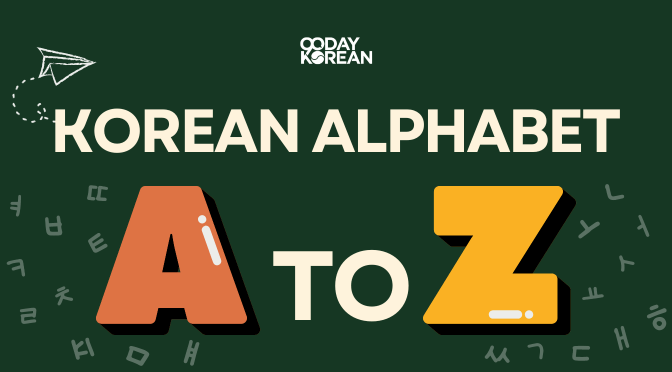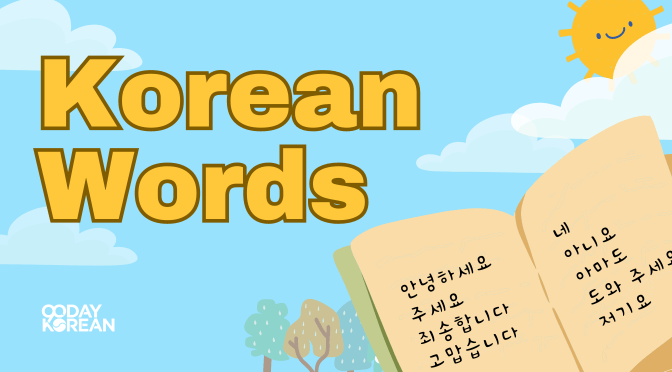If you’re looking to learn the Korean alphabet from A to Z, then you’ve come to the right place! This article will cover all 24 letters of the alphabet and the sounds.
Here are the Hangul letters:
Consonants
ㄱ ㄴ ㄷ ㄹ ㅁ ㅂ ㅅ ㅇ ㅈ ㅊ ㅋ ㅌ ㅍ ㅎ
Vowels
ㅏ ㅑ ㅓ ㅕ ㅗ ㅛ ㅜ ㅠ ㅡ ㅣ
Below, we’ll teach you all the letters of the Korean alphabet, the order of the alphabet, and association.
Contents
Quick Summary
✅ Hangul (The Korean alphabet) consists of 24 basic letters—14 consonants and 10 vowels.
✅ The order of Hangul called 가나다 순 (ganada sun) starts with consonants followed by vowels
✅ Using associations such as ㅁ (m) – Like “m” in “mail” can help you remember the sounds easily
Introduction to Hangul as the Korean Writing System
Hangeul (한글 | also romanized as Hangul) is a unique and scientific alphabet. It is the official writing system used in South Korea. It was created during the reign of King Sejong the Great in the 15th century to enhance literacy among the people who thought Chinese characters difficult and inaccessible.
The Hangul alphabet has 24 basic letters, including 14 consonants and 10 vowels. These letters are combined into syllable blocks that form Korean words. A syllable block includes at least one consonant and one vowel, and it may also include the last consonant.
Korean Consonants Chart
Here is a chart of the 19 Korean consonants.
It includes audio to help with your pronunciation. It also has romanization to help with knowing the closest approximation of the sound in the English alphabet.
| Consonant | Audio | Romanization (initial/final) | Association |
|---|---|---|---|
| ㄴ | n | “g” as in “gun” | |
| ㄷ | d/t | ||
| ㄱ | g/k | “n” in “northeast” | |
| ㄲ | kk/k | “d” in “door” | |
| ㄸ | tt | ||
| ㄹ | r/l | “l” in “ladder” | |
| ㅁ | m | “m” in “mail” | |
| ㅂ | b/p | “b” in “bed” | |
| ㅃ | pp | ||
| ㅅ | s/t | “s” in “seashell” | |
| ㅆ | ss/t | ||
| ㅇ | -/ng | ||
| ㅈ | j/t | “j” in “jug” | |
| ㅉ | jj | ||
| ㅊ | ch/t | “ch” in “church” | |
| ㅋ | k | “k” in “key” | |
| ㅌ | t | “t” in “teeth” | |
| ㅍ | p | “p” in “pie” | |
| ㅎ | h/t | “h” in “hat” |
Korean Vowels Chart
Here is a chart of the 21 Korean vowels.
You can listen to the audio for the correct pronunciation. The romanization helps with knowing the closest approximation of the sound in the English alphabet.
| Vowel | Audio | Romanization | Association |
|---|---|---|---|
| ㅏ | a | “a” as in “father” | |
| ㅐ | ya | “ya” as in “yacht” | |
| ㅑ | ae | “ae” as in “egg” | |
| ㅒ | yae | “yae” as in “yes” | |
| ㅓ | eo | “eo” as in “umbrella” | |
| ㅔ | e | “e” as in “egg” | |
| ㅕ | yeo | “yeo” as in “yummy” | |
| ㅖ | ye | “ye” as in “yes” | |
| ㅗ | o | “o” as in “old” | |
| ㅘ | wa | “wa” as in “waffle” | |
| ㅙ | wae | “wae” as in “wedding” | |
| ㅚ | oe | “oe” as in “wedding” | |
| ㅛ | yo | “yo” as in “yogurt” | |
| ㅜ | u | “u” as in “new” | |
| ㅝ | wo | “wo” as in “won” | |
| ㅞ | we | “we” as in “wedding” | |
| ㅟ | wi | “wi” as in “week” | |
| ㅠ | yu | “yu” as in “unicorn” | |
| ㅡ | eu | “eu” as in “brook” | |
| ㅢ | ui | “ui” as in “gooey” | |
| ㅣ | i | “i” as in “tree” |
Korean Alphabet Pronunciation
Here is the basic pronunciation of Korean alphabet letters. The Korean letters aren’t an exact 1-1 match with the English letters. We’re giving you the closest sound approximation.
For example, the ㄱ is similar to a g/k, but we’ll use “g” for simplicity.
Consonants
- ㄱ (g) – “g” in “gun” (End of syllable: “k“)
- ㄴ (n) – “n” in “northeast”
- ㄷ (d) – “d‘ in “door” (End of syllable: “t“)
- ㄹ (l) – “l” in “ladder” (End of syllable: “l“)
- ㅁ (m) – “m” in “mail”
- ㅂ (b/p) – “b” in “bed” (End of syllable: “p“)
- ㅅ (s) – “s” in “seashell,” when followed by vowelㅣ(i), sounds like “sh.” (End of syllable: “t“)
- ㅇ (ng) – Silent at the beginning of a syllable (End of syllable: “ng” in “sing“)
- ㅈ (j) – “j” in “jar” (End of syllable: “t“)
- ㅊ (ch) – “ch” in “church”
- ㅋ (k) – “k” in “key”
- ㅌ (t) – “t” in “teeth”
- ㅍ (p) – “p” in “pi (π)”
- ㅎ (h) – “h” in “hat”
Note that the actual pronunciation of the consonants can vary based on the position and the surrounding letters.
Vowels
- ㅏ (a) – “a” in “father”
- ㅑ (ya) – “ya” in “yacht”
- ㅓ (eo) – “u” in “umbrella”
- ㅕ (yeo) – “yu” in “yummy”
- ㅗ (o) – “o” in “old”
- ㅛ (yo) – “yo” in “yogurt”
- ㅜ (u) – “ew” in “new“
- ㅠ (yu) – “u” in “unicorn”
- ㅡ (eu) – “oo” in “brook”
- ㅣ (i) – “ee” in “tree“
What is the Korean alphabet from A to Z?
The Korean alphabet has its unique sounds so they don’t exactly match the English alphabet. However, you can approximate some of the English letters using the Korean alphabet.
To learn how to pronounce the Korean alphabet, we don’t recommend relying on corresponding sounds from the English letters. Instead, use the associations, such as “mail for ㅁ”.
You can use the English letters as a rough guide, but they shouldn’t be your go-to source for pronunciation.
The Korean alphabet from A to Z is:
| English | Korean |
|---|---|
| A in Korean | ㅏ |
| B in Korean | ㅂ |
| C in Korean | ㅋ |
| D in Korean | ㄷ, ㄸ |
| E in Korean | ㅔ,ㅐ |
| F in Korean | ㅍ |
| G in Korean | ㄱ |
| H in Korean | ㅎ |
| I in Korean | ㅣ |
| J in Korean | ㅈ |
| K in Korean | ㄱ, ㅋ |
| L in Korean | ㄹ |
| M in Korean | ㅁ |
| N in Korean | ㄴ |
| O in Korean | ㅗ, ㅓ |
| P in Korean | ㅂ, ㅍ |
| Q in Korean | ㅋ |
| R in Korean | ㄹ |
| S in Korean | ㅅ |
| T in Korean | ㅌ |
| U in Korean | ㅜ |
| V in Korean | ㅂ |
| W in Korean | ㅝ, ㅟ |
| X in Korean | ㅈ |
| Y in Korean | 예, 얘 |
| Z in Korean | ㅈ |
Order of the Korean alphabet letters
The order of Hangeul (Korean alphabet) is called 가나다 순 (ganada sun). 가나다 is equivalent to “ABC” in English. 가나다 is made of the first three consonants, ㄱ, ㄴ, ㄷ, combined with the first vowel in order, ㅏ.
The Korean alphabetical order separates the consonants and vowels. The consonant letters come first, then the vowel letters.
Here is the order of the basic consonants:
ㄱ ㄴ ㄷ ㄹ ㅁ ㅂ ㅅ ㅇ ㅈ ㅊ ㅋ ㅌ ㅍ ㅎ
Here is the order of the basic vowels:
ㅏ ㅑ ㅓ ㅕ ㅗ ㅛ ㅜ ㅠ ㅡ ㅣ
The Korean alphabet also has double consonants, which are a combination of two basic consonants. There are also vowel combinations, which are made up of two basic vowels. These letters make different sounds that basic letters don’t.
Here are the double consonants in order:
ㄲ ㄸ ㅃ ㅆ ㅉ
Here are the vowel combinations in order:
ㅐ ㅒ ㅔ ㅖ ㅘ ㅙ ㅚ ㅝ ㅞ ㅟ ㅢ
Below is a table for the Korean alphabet in order.
| Hangul | Romanization |
|---|---|
| g/k | |
| kk | |
| d/t | |
| tt | |
| r/l | |
| m | |
| n | |
| b/p | |
| pp | |
| s/t | |
| ss | |
| ng | |
| j | |
| jj | |
| ch | |
| k | |
| t | |
| p | |
| h | |
| a | |
| ya | |
| ae | |
| yae | |
| eo | |
| e | |
| yeo | |
| ye | |
| o | |
| wa | |
| wae | |
| oe | |
| yo | |
| u | |
| wo | |
| we | |
| wi | |
| yu | |
| eu | |
| ui | |
| i |
We recommend learning about them in this order:
Basic Consonants
| Korean | Romanization |
|---|---|
| g/k | |
| n | |
| d/t | |
| r/l | |
| m | |
| b/p | |
| s(/t) | |
| ng | |
| j/ch | |
| h | |
| ch(/t) | |
| k | |
| t | |
| p |
Basic Vowels
| Vowels | Romanized Spelling |
|---|---|
| a | |
| eo | |
| o | |
| u | |
| eu | |
| i | |
| ya | |
| yeo | |
| yo | |
| yu |
Double Consonants
| Double Consonants | Romanization |
|---|---|
| kk | |
| tt | |
| pp | |
| ss | |
| jj |
Vowel Combinations
| Vowels | Romanized Spelling |
|---|---|
| ae | |
| e | |
| yae | |
| ye | |
| wa | |
| wae | |
| oe | |
| wo or weo | |
| we | |
| wi | |
| ui |
What is a in Korean?
“a” is ㅏ. This is a vowel called 아 (a).
Example: If you wanted to sound out the English word “father” using the Korean script, you’d use ㅏ.
What is b in Korean?
“b” is ㅂ. This is a consonant called 비읍 (bieup).
Example: If you wanted to sound out the English word “bar” using the Korean script, you’d start with ㅂ.
What is c in Korean?
“c” is ㅋ. This is a consonant called 키읔 (kieuk).
Example: If you wanted to sound out the English word “car” using the Korean script, you’d start with ㅋ.
What is d in Korean?
“d” is ㄷ. This is a consonant called 디귿 (digeut)
Example: If you wanted to sound out the English word “door” using the Korean script, you’d start with ㄷ.
What is e in Korean?
“e” is ㅔ. This is a vowel called 에 (e).
Example: If you wanted to sound out the English word “egg” using the Korean script, you’d start with ㅔ.
What is f in Korean?
“f” is ㅍ. This is a consonant called 피읖 (pieup).
Example: If you wanted to sound out the English word “far” using the Korean script, you’d start with ㅍ.
What is g in Korean?
“g” is ㄱ. This is a consonant called 기역 (giyeok).
Example: If you wanted to sound out the English word “gun” using the Korean script, you’d start with ㄱ.
What is h in Korean?
“h” is ㅎ. This is a consonant called 히읕 (hieut).
Example: If you wanted to sound out the English word “hat” using the Korean script, you’d start with ㅎ.
What is i in Korean?
“i” is ㅣ. This is a vowel called 이 (i).
Example: If you wanted to sound out the English word “bee” using the Korean script, you’d use ㅣ.
What is j in Korean?
“j” is ㅈ. This is a consonant called 지읏 (jieut).
Example: If you wanted to sound out the English word “jug” using the Korean script, you’d start with ㅈ.
What is k in Korean?
“k” is ㅋ. This is a consonant called 키읔 (kieuk).
Example: If you wanted to sound out the English word “kite” using the Korean script, you’d start with ㅋ.
What is l in Korean?
“l” is ㄹ. This is a consonant called 리을 (rieul).
Example: If you wanted to sound out the English word “love” using the Korean script, you’d start with ㄹ.
What is m in Korean?
“m” is ㅁ. This is a consonant called 미음 (mieum).
Example: If you wanted to sound out the English word “mail” using the Korean script, you’d start with ㅁ.
What is n in Korean?
“n” is ㄴ. This is a consonant called 니은 (nieun).
Example: If you wanted to sound out the English word “northeast” using the Korean script, you’d start with ㄴ.
What is o in Korean?
“o” is ㅗ. This is a vowel called 오 (o).
Example: If you wanted to sound out the English word “go” using the Korean script, you’d use ㅗ.
What is p in Korean?
“p” is ㅍ. This is a consonant called 피읖 (pieup).
Example: If you wanted to sound out the English word “pop” using the Korean script, you’d start with ㅍ.
What is q in Korean?
“q” is ㅋ. This is a consonant called 키읔 (kieuk).
Example: If you wanted to sound out the English word “queen” using the Korean script, you’d start with ㅋ.
What is r in Korean?
“r” is ㄹ. This is a consonant called 리을 (rieul).
Example: If you wanted to sound out the English word “red” using the Korean script, you’d start with ㄹ.
What is s in Korean?
“s” is ㅅ. This is a consonant called 시옷 (siot).
Example: If you wanted to sound out the English word “seashell” using the Korean script, you’d start with ㅅ.
What is t in Korean?
“t” is ㅌ. This is a consonant called 티읕 (tieut).
Example: If you wanted to sound out the English word “teeth” using the Korean script, you’d start with ㅌ.
What is u in Korean?
“u” is ㅜ. This is a vowel called 우 (u).
Example: If you wanted to sound out the English word “blue” using the Korean script, you’d use ㅜ.
What is v in Korean?
“v” is ㅂ. This is a consonant called 비읍 (bieup). The “v” sound is typically represented with a “b” sound in Korean.
Example: If you wanted to sound out the English word “van” using the Korean script, you’d start with ㅂ.
What is w in Korean?
“w” can be written as a combination of vowels, such as ㅘ (와| wa), ㅝ (워| wo), ㅟ (위| wi), ㅚ, (외| oe), or ㅙ (왜| wae).
Example: If you wanted to sound out the English word “waffle” using the Korean script, you’d start with ㅘ.
What is x in Korean?
“x” is ㅈ (지읒| jieut) or -ㄱ스 (-kseu).
Example: If you wanted to sound out the English word “Xerox” using the Korean script, you’d start with ㅈ and end with -ㄱ스 , like 제록스 (jerokseu).
What is y in Korean?
“y” is ㅣ. This is a vowel called 이 (i).
“y” is usually combined with vowels, creating these syllables:ㅑ (야 | ya), ㅕ (여| yeo), ㅛ (요| yo), or ㅠ (유| yu).
Example: If you wanted to sound out the English word “yacht” using the Korean script, you’d start with 야.
What is z in Korean?
“z” is ㅈ. This is a consonant called 지읒 (jieut). The “z” sound is typically represented by a “j” sound in the Korean language.
Example: If you wanted to sound out the English word “zero” using the Korean script, you’d start with ㅈ.
What to do after learning the Korean Alphabet A to Z
Once you have mastered the Korean characters from A to Z, here are the next steps that you can take:
- Korean Alphabet – Learn the associations and read all letters
- Korean Alphabet Pronunciation – Learn the correct pronunciation of Korean letters and words
- Speak Korean – Start speaking basic Korean
Conclusion
Today, you’ve learned the basics of Hangeul, how to remember them effectively, and how to write English sounds using the Korean script.
Reading and writing Korean words will become a lot easier. You should now be able to recognize these Korean letters as you see them in Korean products, menus, or K-Dramas that you watch.
Remember to use the associations to remember the alphabet sounds instead of the English letters. For example, use “mail” for ㅁ, not “m.”
What questions do you have about the Korean alphabet from A to Z? Let us know in the comments below!






it was very helpful but how do i practice it and what korean learning materials(books, apps) would i need
Hi Zoe! Glad to hear you found the article helpful. ^^ To practice the Korean Alphabet, you might want to check out our article on How to Pronounce Korean Alphabet – Mastering Hangeul Sounds. For Korean learning materials like books and apps, our articles on Best Apps to Learn Korean and Best Korean Textbooks for Language Learning should help you with that. Happy learning! ^^